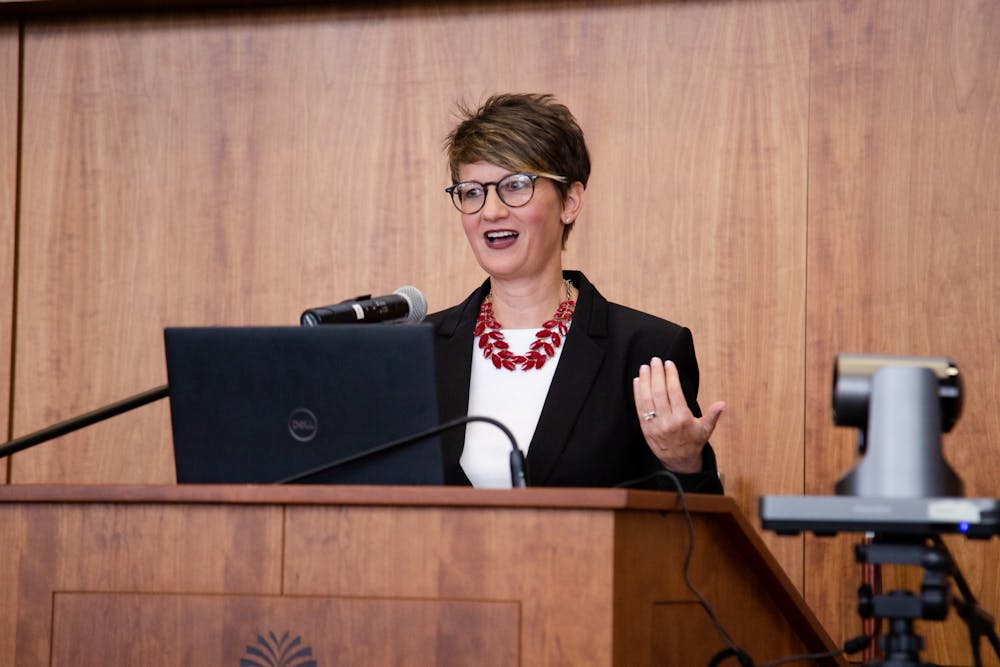The vice president of student affairs is one of the many positions that will see change. Brandi Hephner LaBanc, out of the three candidates that came to visit, took stands on mental health and the importance of diversity and inclusion, making her the best candidate for the job.
The current VP for student affairs, Dennis Pruitt, is stepping down after almost 40 years of running the department. The role oversees the student experience — ensuring they get connected to opportunities beyond the university — helps students with their time at the university in terms of belonging and is in charge of programs, services and initiatives that have to do with students.
The finalists for the vice president of student affairs and academic support are Darryl B. Holloman, the vice president for student affairs at Spelman College, Brandi Hephner LaBanc, the vice chancellor for student affairs and campus life at the University of Massachusetts Amherst and J. Rex Tolliver, the vice president for student affairs at the University of Illinois Chicago.
The finalists visited USC's campus from July 7 to July 14, attending meetings with students and holding forums open to anyone at the university.
While all candidates were passionate about their jobs, qualified and looked excited to join the USC family, LaBanc seemed like the best fit because of her experience at a similar school and her passion about making USC a more diverse and inclusive place.
LaBanc presented on July 11, giving a little information about her personal life and her three main areas of concern which were diversity, equity and inclusion (DEI) and belonging, mental health and wellbeing and revising our work and workplace.
What stood out with LaBanc is instead of putting a couple of words on the screen under each concern like Holloman did in his presentation, she put why they are her concerns and some strategies to combat them.
Tolliver's four main areas were similar to Lebanc's as he had mental health and well-being and advancing equity, diversity, inclusion, justice and the campus climate. He also had the consumer approach to higher education and the expectation of staff and students. While Holloman's approach to his three main concerns was a lot broader –belonging, community and pre-existing trauma.
One thing however that was consistent throughout all candidates was the importance of mental health. There are about 28,000 students on this campus and no one should fall through the cracks. It's important that all faculty and staff members, not just staff at the counseling center are looking out for students in need. The new vice president of student affairs needs to ensure this.
"I think the mental health and wellbeing specifically I like to sit down and think about wellbeing is part of our educational obligations," LeBanc said.
LeBanc, in her presentation, brought up that USC needs to be a health-promoting university, which would require everyone to participate to ensure mental health across the board is thriving.
Another major area that the new vice president of student affairs needs to focus on is listening. Students have a different perspective than anyone else on campus, especially senior leaders. The student body needs someone who will listen and take those concerns into mind. Both LeBanc and Hollomon stressed the importance of student input.
"What is most important are the skill sets that I've learned over time, and that's to listen," Holloman said. "People have asked me what would you do in the first 90 days. I would do a lot of listening."
It's also important that these candidates can adapt to the campus. While Hollomon currently works at Spelman, a small college with 2,200 students and Tolliver works at the University of Illinois Chicago which has around 22,000 students. LaBanc works at the University of Massachusetts Amherst, with a population of about 22,000 which mirrors USC closely among other things.
USC is also considered a flagship university which is often the biggest university in the state and gets the most help from the state government. USC is also an R1 university, which means we are one of the best research schools. LaBanc's current school is also a flagship and has R1 status. While UIC has the same amount of students and R1 status, it's not a flagship university.
Another area that was similar across the board was the conversation about diversity and inclusion. However, LeBanc took the time to do her research about the diversity at the school, looking at our statistics for minority students and how they mirror the population.
"We should be attracting and educating a student body that looks like the society," LaBanc said. "It is clear that the undergraduate students and graduate students on this campus — there is a lag in many of minoritized communities."
She also has plans to work with the DEI advisory council to ensure our campus mirrors the population and that our retention rate isn't lagging.
All candidates are qualified for the job and have the passion to work at USC. LaBanc and Tolliver gave very similar approaches and would fit well here. However, LaBanc, with her experience at a similar school, is the right person for the job.
This upcoming semester students will see a lot of change in leadership. The vice president of student affairs needs to have a plan to help with campus-wide mental health challenges, has to want student input and cares about fixing the disparity of minority students. LaBanc will hopefully be that person and be the advocate the students need.

